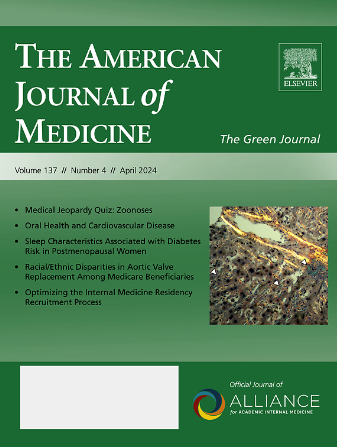19岁后美国成年人使用辅助药物的情况:2022 年全国健康访谈调查的结果。
IF 2.5
3区 医学
Q1 MEDICINE, GENERAL & INTERNAL
引用次数: 0
摘要
研究目的本研究旨在调查具有代表性的美国成年人样本中自我报告的COVID-19后症状的补充医学(CM)使用率和类型,以及与CM使用相关的潜在因素:这项二手数据分析基于 2022 年全国健康访谈调查(NHIS)中关于有代表性的成人样本(加权 n = 89,437,918 人)中是否存在 COVID-19 后症状和使用中药的数据:我们的估计结果表明,在报告有症状的 SARS-CoV-2 感染者中,19.7% 的人出现过 COVID-19 后症状,46.2% 的人报告在过去 12 个月中使用过任何类型的中药。具体而言,COVID-19 后的受访者最常使用的是心身医学(32.0%),其次是按摩(16.1%)、脊椎按摩(14.4%)、针灸(3.4%)、自然疗法(2.2%)以及艺术和/或音乐疗法(2.1%)。报告 COVID-19 后与过去 12 个月中使用任何中药的可能性增加有关(AOR = 1.18,95% CI [1.03,1.34],p = 0.014),特别是与访问艺术和/或音乐治疗师有关(AOR = 2.56,95% CI [1.58,4.41],p < 0.001)。COVID-19调查后的受访者中,65岁以下、女性、具有西班牙裔、非裔美国人、亚裔或非西班牙裔白人以外的种族背景、受教育程度较高、居住在大都市地区以及拥有私人医疗保险的受访者更有可能使用任何中药:我们的研究结果表明,COVID-19 后受访者中使用中药的比例很高,这突出表明有必要进一步调查其有效性、安全性和可能的作用机制。本文章由计算机程序翻译,如有差异,请以英文原文为准。
Use of Complementary Medicine Among US Adults with Post-COVID-19: Results from the 2022 National Health Interview Survey
Objective
The aim of this study was to investigate the prevalence and type of complementary medicine (CM) use as well as potential factors related to CM use in a representative sample of US adults with self-reported post-COVID-19.
Methods
This secondary data analysis was based on data from the 2022 National Health Interview Survey 2022 about presence of post-COVID-19 symptoms and CM use in a representative adult sample (weighted n = 89,437,918).
Results
Our estimates indicate that 19.7% of those who reported having a symptomatic SARS-CoV-2 infection experienced post-COVID-19 symptoms, and 46.2% of those reported using any type of CM in the last 12 months. Specifically, post-COVID-19 respondents most often used mind-body medicine (32.0%), followed by massage (16.1%), chiropractic (14.4%), acupuncture (3.4%), naturopathy (2.2%), and art or music therapy (2.1%). Reporting post-COVID-19 was associated with an increased likelihood of using any CM in the last 12 months (adjusted odds ratio [AOR] 1.18; 95% confidence interval [CI]. 1.03-1.34; P = .014) and specifically, to visit an art or music therapist (AOR 2.56; 95% CI, 1.58–4.41; P < .001). The overall use of any CM was more likely among post-COVID-19 respondents under 65 years old, females, those with an ethnic background other than Hispanic, African-American, Asian, or non-Hispanic Whites, having a higher educational level, living in large metropolitan areas, and having private health insurance.
Conclusions
Our findings show a high prevalence of CM use among post-COVID-19 respondents, which highlights the need for further investigations on effectiveness, safety, and possible mechanisms of action.
求助全文
通过发布文献求助,成功后即可免费获取论文全文。
去求助
来源期刊

American Journal of Medicine
医学-医学:内科
CiteScore
6.30
自引率
3.40%
发文量
449
审稿时长
9 days
期刊介绍:
The American Journal of Medicine - "The Green Journal" - publishes original clinical research of interest to physicians in internal medicine, both in academia and community-based practice. AJM is the official journal of the Alliance for Academic Internal Medicine, a prestigious group comprising internal medicine department chairs at more than 125 medical schools across the U.S. Each issue carries useful reviews as well as seminal articles of immediate interest to the practicing physician, including peer-reviewed, original scientific studies that have direct clinical significance and position papers on health care issues, medical education, and public policy.
 求助内容:
求助内容: 应助结果提醒方式:
应助结果提醒方式:


